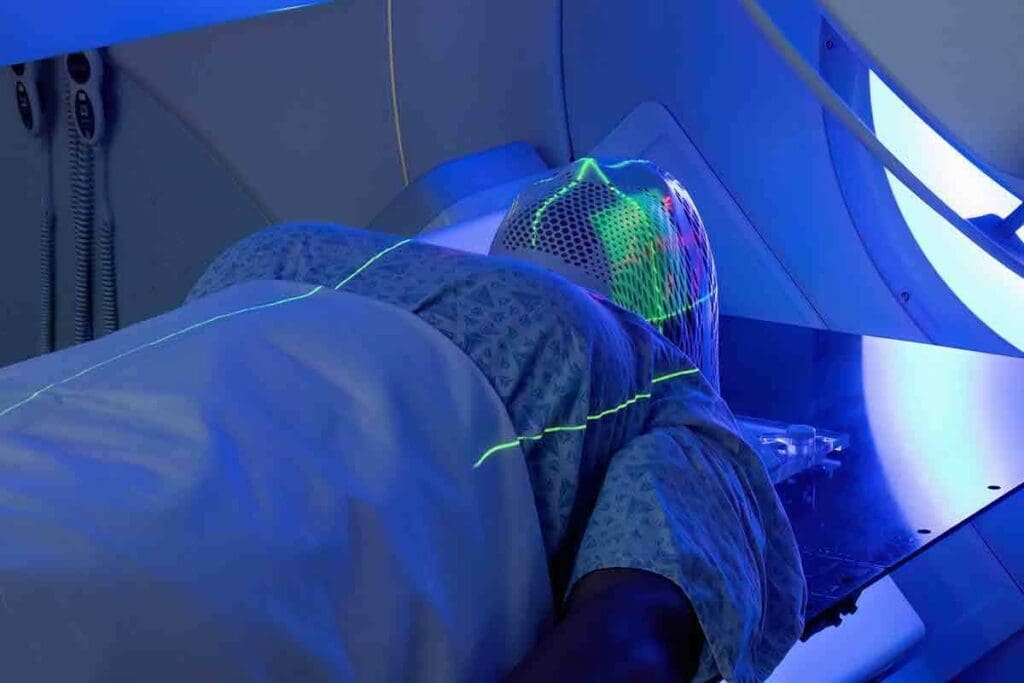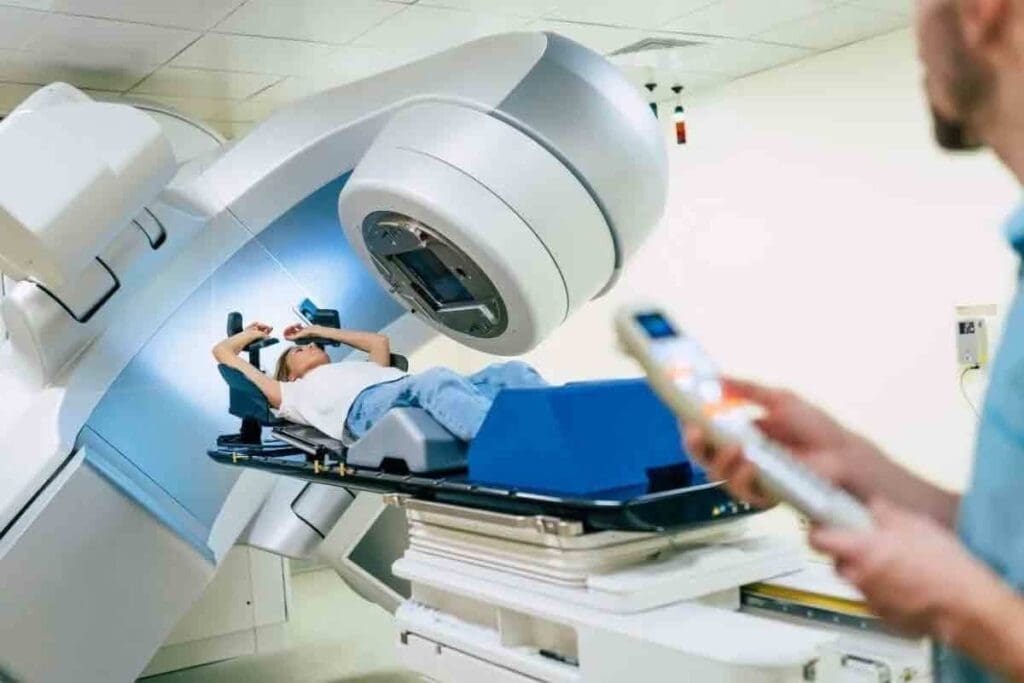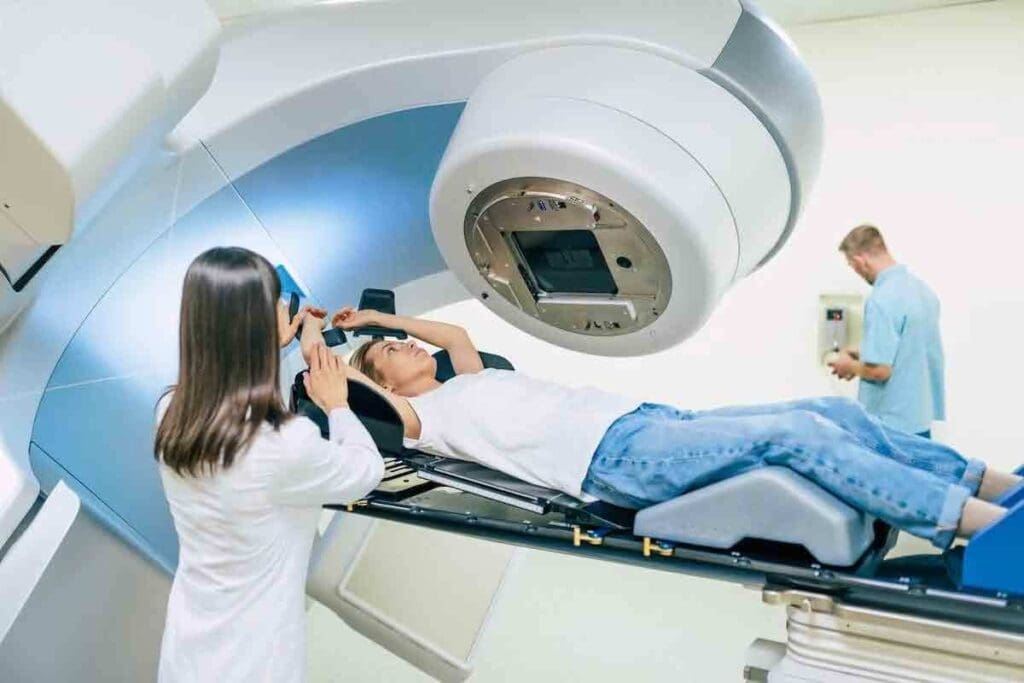Last Updated on November 27, 2025 by Bilal Hasdemir

For those thinking about liquid radiotherapy, knowing what it is and its benefits is key. At Liv Hospital, safety and top-notch medical care are always first.
Liquid radiotherapy is a way to fight cancer by using a radioactive substance. It’s given to treat certain cancers like lymphoma, neuroendocrine tumors, and thyroid cancer. The goal is to reduce tumor size without harming healthy tissues.
Key Takeaways
- Liquid radiotherapy targets cancer cells throughout the body.
- It’s used for specific types of cancer, such as lymphoma and thyroid cancer.
- The treatment involves administering a radioactive substance.
- Patient safety is a top priority at Liv Hospital.
- The goal is to maximize tumor shrinkage while protecting healthy tissues.
Understanding Liquid Radiotherapy

Liquid radiotherapy, also known as internal radiation therapy, is a complex treatment. It involves giving radioactive substances orally or through an IV line. This method targets cancer cells all over the body. It’s effective for certain cancers like lymphoma and thyroid cancer.
Definition and Basic Principles
Liquid radiotherapy is a type of systemic therapy. It uses a radioactive liquid to kill cancer cells. The liquid is made to target cancer cells, ensuring precise treatment.
This method allows the treatment to reach cancer cells in different parts of the body. The basic idea is to give a high dose of radiation to cancer cells. At the same time, it tries to protect healthy tissues around them.
How Liquid Radiotherapy Differs from External Beam Radiation
Liquid radiotherapy is different from external beam radiation therapy. External beam radiation uses a machine to send radiation beams at the cancer from outside. Liquid radiotherapy, on the other hand, involves giving a radioactive substance directly into the body.
This internal approach is more targeted, which is great for cancers that have spread. It’s given orally or through an IV line.
- Liquid radiotherapy is administered orally or through an IV line.
- It targets cancer cells throughout the body.
- The treatment involves a radioactive isotope linked to a molecule that selectively targets cancer cells.
Types of Radioisotopes Used in Treatment
Many radioisotopes are used in liquid radiotherapy, each for different cancers. Some common ones include:
| Radioisotope | Application |
| Iodine-131 | Thyroid cancer |
| Yttrium-90 | Lymphoma and certain types of leukemia |
| Lutetium-177 | Neuroendocrine tumors |
The choice of radioisotope depends on the cancer’s type and the patient’s health.
Medical Conditions Treated with Liquid Radiotherapy

Liquid radiotherapy is a key treatment for many cancers and diseases. It’s great for conditions where precise treatment is needed.
Thyroid Cancer and Radioactive Iodine
Thyroid cancer is often treated with liquid radiotherapy, using radioactive iodine (I-131). This iodine targets thyroid cells, killing cancerous ones. It’s a proven treatment for some thyroid cancers.
Lymphomas and Related Blood Cancers
Liquid radiotherapy also helps with lymphomas and blood cancers. Radioisotopes like Yttrium-90 are used for targeted treatments. This method is precise, protecting healthy tissues.
Neuroendocrine Tumors
Neuroendocrine tumors can be treated with liquid radiotherapy. These tumors need specific treatments. Radioisotopes target tumor cells, helping patients.
Non-Cancerous Applications
Liquid radiotherapy is also used for non-cancerous conditions. For example, it treats hyperthyroidism by reducing thyroid hormone. This shows its wide range of uses.
| Medical Condition | Radioisotope Used |
| Thyroid Cancer | I-131 |
| Lymphomas | Yttrium-90 |
| Neuroendocrine Tumors | Lutetium-177 |
| Hyperthyroidism | I-131 |
Preparation for Liquid Radiotherapy
Before starting liquid radiotherapy, patients must prepare thoroughly. This step is key to making sure the treatment works well and is safe.
Initial Consultation and Assessment
The journey starts with an initial consultation and assessment with a radiation oncologist. The doctor will check the patient’s health, talk about the cancer, and explain the treatment plan. This is a chance for patients to ask questions and know what to expect.
“The initial consultation is a critical step in the preparation process, as it allows the healthcare team to tailor the treatment to the individual patient’s needs.” –
Expert in Radiation Oncology
Required Medical Tests
To understand the cancer and the patient’s health, several medical tests are needed. These might include blood work, CT scans, or PET scans, and other tests. The results help plan the treatment.
| Test Type | Purpose |
| Blood Work | Evaluate overall health and detect any abnormalities |
| Imaging Studies (CT, PET) | Assess the extent of cancer and its spread |
| Other Diagnostic Procedures | Provide additional information necessary for treatment planning |
Dietary and Medication Restrictions
Before liquid radiotherapy, patients might need to follow certain dietary and medication restrictions. These rules help avoid side effects and make the treatment more effective. The healthcare team will give clear instructions on what to eat, avoid, and any medications to stop or adjust.
Mental and Emotional Preparation
Mental and emotional preparation is also important. Patients might feel anxious or scared about the treatment. It’s good to talk about these feelings with family, friends, or counselors. They can offer support and help.
- Seek support from family and friends.
- Consider professional counseling
- Discuss concerns with the healthcare team.
By following these steps, patients can be ready for liquid radiotherapy. This ensures the best results.
How Liquid Radiotherapy Is Administered
Liquid radiotherapy can be given in different ways. Each method has its own benefits and things to consider. The choice depends on the cancer type, the patient’s health, and the radioactive isotope used.
Oral Administration Methods
Oral administration means swallowing a capsule or liquid with the radioactive isotope. It’s often used for thyroid cancer with radioactive iodine. Patients get clear instructions to ensure safety and effectiveness.
Intravenous Infusion Procedures
Intravenous infusion puts the radioactive isotope directly into a vein. It lets the isotope reach cancer cells through the bloodstream. This method is used for some lymphomas and cancers. It’s done in a medical setting to keep others safe from radiation.
Direct Injection Techniques
Direct injection puts the radioactive isotope right into the tumor or affected area. It’s for specific cancers and needs precise targeting. This helps avoid harming nearby tissues.
Hospital Setting vs. Outpatient Treatment
Where liquid radiotherapy is given can vary. Some treatments happen in hospitals, for closer monitoring or complex conditions. Others are done as outpatient treatments, so patients can go home soon after. The choice depends on the isotope, dose, and the patient’s health.
Patients getting liquid radiotherapy are watched closely for how they react and any side effects. This makes sure the treatment works well and any problems are quickly fixed.
The Liquid Radiotherapy Procedure Step by Step
Learning about the liquid radiotherapy process can ease patient worries and improve results. It includes key steps from setting up the patient to aftercare. These steps ensure the safe and effective use of the radioactive isotope.
Patient Positioning and Comfort Measures
Getting the patient in the right position is key for liquid radiotherapy. They are placed on a special table to get the radioactive isotope right. Comfort measures are also used to reduce any discomfort during the treatment.
Administration of the Radioisotope
Administering the radioisotope is a precise step tailored for each patient. It can be given orally, through an IV, or by injection. This depends on the cancer type and the radioisotope used.
Monitoring During Treatment
Patients are watched closely during treatment for their safety and comfort. Their vital signs are tracked, and any bad reactions to the isotope are noted. The team is ready to handle any issues that come up.
Immediate Post-Administration Care
After the isotope is given, patients get care to lessen side effects and help them recover. They are taught about radiation safety and set up for follow-up checks to track their progress.
| Procedure Step | Description | Key Considerations |
| Patient Positioning | Careful positioning on a treatment table | Accuracy, comfort |
| Radioisotope Administration | Oral, intravenous, or direct injection | Type of cancer, radioisotope used |
| Monitoring During Treatment | Vital sign tracking, adverse reaction observation | Patient safety, comfort |
| Post-Administration Care | Guidance on radiation safety, follow-up appointments | Minimizing side effects, recovery |
Duration and Treatment Schedules
The length of liquid radiotherapy treatment varies based on several factors. These include the type and stage of cancer. Liquid radiotherapy, also known as systemic radiotherapy, targets cancer cells with radioactive isotopes. Each patient’s treatment duration and schedule can differ greatly.
Single-Dose vs. Multiple Treatment Sessions
Liquid radiotherapy can be given in one dose or multiple sessions. The choice depends on the patient’s condition and treatment goals.
- Single-Dose Treatment: Some patients get a single dose of radioactive isotope. This is common for certain thyroid cancers treated with radioactive iodine.
- Multiple Treatment Sessions: Others need multiple sessions, spread over weeks or months. This is to achieve the best treatment effect.
Factors Affecting Treatment Length
Several factors can change the length of liquid radiotherapy treatment. These include:
- The type and stage of cancer being treated
- The specific radioactive isotope used
- The patient’s overall health and response to treatment
- The treatment protocol, which may be adjusted based on the patient’s progress
Follow-up Schedule After Treatment
After liquid radiotherapy, patients follow a schedule for monitoring and managing side effects. This schedule includes:
- Regular check-ups with the healthcare provider
- Imaging tests to assess the treatment’s effectiveness
- Blood tests to monitor the patient’s overall health
Follow-up care is key for the best outcomes and addressing any issues that may come up.
Safety Precautions After Liquid Radiotherapy
After getting liquid radiotherapy, patients need to take steps to lower their radiation exposure. They should know that their bodily fluids, like urine and sweat, can release radiation. This is important for their safety and the safety of others.
Radiation Emission from Bodily Fluids
Radiation in bodily fluids can be a risk, mainly for pregnant women and kids. To lower this risk, patients should follow certain rules for handling these fluids.
- Flush the toilet twice after use to ensure that radioactive waste is properly disposed of.
- Wash your hands thoroughly with soap and water after using the bathroom.
- Avoid sharing personal items like utensils, towels, or clothing.
Guidelines for Interacting with Family Members
Patients should limit contact with family, like pregnant women and kids, for a while after treatment. The length of time depends on the radioisotope used.
To reduce exposure, patients can do the following:
- Sleep in a separate bed from their partner.
- Avoid close contact, such as hugging or kissing.
- Maintain a safe distance from others, especially children and pregnant women.
Duration of Safety Precautions
The length of time for safety precautions varies based on the radioisotope and the patient’s health. Patients will get specific advice from their healthcare provider.
It’s very important to follow these guidelines to lower radiation exposure to others. By doing so, patients can protect themselves and those around them.
Side Effects and Management
It’s important for patients to know about the side effects of liquid radiotherapy. This treatment can cause various side effects, from mild to severe. Knowing these can help manage them better.
Common Short-Term Side Effects
Short-term side effects include fatigue, nausea, hair loss, and changes in blood counts. These effects are usually temporary and go away after treatment ends.
Common short-term side effects:
- Fatigue
- Nausea and vomiting
- Hair loss
- Changes in blood counts
Potential Long-Term Effects
Long-term side effects are less common but can be serious. They include damage to healthy tissues, an increased risk of secondary cancers, and hormonal imbalances. Regular check-ups with healthcare providers are key to monitoring these effects.
Potential long-term risks:
- Damage to healthy tissues
- Increased risk of secondary cancers
- Hormonal imbalances
Managing Side Effects at Home
Managing side effects at home requires lifestyle changes and medical help. Patients should drink plenty of water, eat well, and rest. Doctors may prescribe medications for specific symptoms.
| Side Effect | Management Tip |
| Fatigue | Rest techniques |
| Nausea | Anti-nausea medication, dietary changes |
| Hair Loss | Scalp cooling, gentle hair care |
When to Seek Medical Attention
Patients need to know when to seek medical help. Severe or ongoing side effects, signs of infection, or unusual symptoms need immediate attention from healthcare providers.
Warning signs:
- Severe pain or difficulty breathing
- Fever or signs of infection
- Severe nausea or vomiting
Conclusion: Effectiveness and Future of Liquid Radiotherapy
Liquid radiotherapy is showing great promise in treating certain cancers like lymphoma and thyroid cancer. It works by targeting cancer cells without harming the healthy tissue around them.
Researchers are working hard to make liquid radiotherapy even better. They aim to find new ways to use it to help more people. This could lead to new treatments and better outcomes for cancer patients.
The outlook for liquid radiotherapy is bright. It could lead to even better results and fewer side effects. As scientists keep studying, liquid radiotherapy might become a key part of cancer treatment. It could offer patients more effective and targeted ways to fight their disease.
FAQ
What is liquid radiotherapy?
Liquid radiotherapy, also known as systemic radiotherapy, is a treatment. It involves giving a radioactive liquid to target cancer cells all over the body.
How is liquid radiotherapy administered?
It can be given in different ways. This includes taking it by mouth, through an IV, or by direct injection. The method depends on the cancer type and the patient’s health.
What are the common side effects of liquid radiotherapy?
Short-term side effects include feeling tired, nausea, and hair loss. Long-term effects might harm healthy tissues and organs.
How long does liquid radiotherapy last?
Treatment time varies. It can last from a few days to weeks or months. This depends on the cancer type, its stage, and the treatment plan.
Are you radioactive after liquid radiotherapy?
Yes, you may release radiation through your fluids like urine, sweat, and saliva. After treatment, follow safety guidelines to protect others.
What safety precautions should be taken after liquid radiotherapy?
Avoid close contact with family, like pregnant women and kids. Follow specific guidelines to reduce exposure to others.
How effective is liquid radiotherapy?
It’s effective for certain cancers like lymphoma and thyroid cancer. Research is ongoing to explore more uses.
What is radiotherapy used for?
Radiotherapy, including liquid radiotherapy, treats various conditions. This includes cancer and some non-cancerous conditions, like thyroid issues.
Does liquid radiotherapy shrink tumors?
Yes, it aims to shrink tumors while protecting healthy tissues.
How long do the effects of liquid radiotherapy last?
Effects vary based on the cancer type, its stage, and the treatment. Follow-up care is key to monitoring the patient’s response.
What happens during liquid radiotherapy?
Patients lie on a table during treatment. The radioisotope is given according to the plan. They are monitored for safety and comfort.
Can liquid radiotherapy be used for non-cancerous tumors?
Yes, it can treat non-cancerous conditions, like certain thyroid issues.
How is liquid radiotherapy different from external beam radiation therapy?
Liquid radiotherapy uses a radioactive liquid inside the body. External beam radiation therapy directs beams from outside the body.
Reference:
Cambridge University Hospitals NHS Foundation Trust. (2024). Radical radiotherapy for non-small cell lung cancer (NSCLC). https://www.cuh.nhs.uk/patient-information/radical-radiotherapy-for-non-small-cell-lung-cancer-nsclc/






